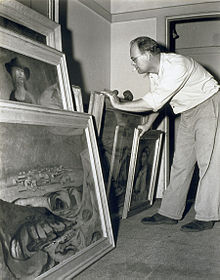|
Artist > Russell Drysdale (23 paintings.) |

Early life and career
George Russell Drysdale was born in Bognor Regis, Sussex, England, to an Anglo-Australian pastoralist family, which settled in Melbourne, Australia in 1923. Drysdale was educated at the Geelong Grammar School. He had poor eyesight all his life, and was virtually blind in his left eye from age 17 due to a detached retina.
Drysdale worked on his uncle's state in Queensland, and as a jackaroo in Victoria.[1]. A chance encounter in 1932 with artist and critic Daryl Lindsay awakened him to the possibility of a career as an artist. Supported by a fellow artist, Drysdale studied with the modernist artist and teacher George Bell in Melbourne from 1935 to 1938. He also made several trips to Europe; during 1938-39, he attended the Grosvenor School in London and the Grande Chaumiere in Paris.[3] By the time of his return from the third of these trips in June 1939 Drysdale was recognised within Australia as an important emerging talent, but had yet to find a personal vision. His decision to leave Melbourne for Albury and then Sydney in 1940 was instrumental in his discovery of his life-long subject matter, the Australian outback and its inhabitants. Equally important was the influence of fellow artist Peter Purves-Smith in guiding him towards his characteristic mature style with its use of desolate landscapes inhabited by sparse figures under ominous skies.[citation needed]

Drysdale's 1942 solo exhibition in Sydney (his second in point of time - his first had been in Melbourne in 1938) was a critical success, and established him as one of the leading Sydney modernists of the time, together with William Dobell, Elaine Haxton, and Donald Friend. In 1944, The Sydney Morning Herald sent him into far western New South Wales "to illustrate the effects of the then-devastating drought".[4] With his series of paintings of drought-ravaged western New South Wales and, later, a series based on the derelict gold-mining town of Hill End, his reputation continued to grow during the 1940s. A painting of the nearby town of Sofala won the Wynne Prize for landscape in 1947.
His 1950 exhibition at London's Leicester Galleries, at the invitation of Sir Kenneth Clark, was a significant milestone in the history of Australian art. Until this time, Australian art had been regarded as a provincial sub-species of British art; Drysdale's works convinced British critics that Australian artists had a distinctive vision of their own, exploring a physical and psychological landscape at once mysterious, poetic, and starkly beautiful. The exhibition initiated the international recognition of Australian art that quickly came to include Dobell, Sidney Nolan, Arthur Boyd, Clifton Pugh, and others who came to national and international prominence in the 1950s.
Drysdale's reputation continued to grow throughout the 1950s and 1960s as he explored remote Australia and its inhabitants. In 1954, together with Nolan and Dobell, he was chosen to represent Australia at the Venice Biennale, and in 1960, at Bouddi near Gosford, New South Wales.
In 1969, Drysdale was knighted for his services to art, and in 1980, he was awarded the Companion of the Order of Australia in 1980.[5] His latter years saw a marked falling off in the quantity of his output, which had never been large, and died in Sydney on 29 June 1981.
He was married twice, and had a son, Tim, and a daughter, Lynne. Tim took his life in 1962, aged twenty one, and the following year his wife Bon also committed suicide. In 1964 Drysdale married Maisie Purves Smith, an old friend. [6]
Australian art scholar and gallery director Ron Radford argues that towards the end of World War II, Drysdale triggered "'a general reddening' of Australian landscape art".[7] Radford describes Drysdale's work as follows: "His dried up earth suggested that man had lost control of the land - nature had fought back and taken back".[7] Drysdale's Australia was "hot, red, isolated, desolate and subtly threatening".[8] His The Drover's Wife "cohabits in Australians' minds with Nolan's Carcass paintings" as conveying a sense of desolation.[8] Dysdale's red presents "a landscape deeply, intrinsically inhospitable" and conveys the "utter alienation" of the figures he paints in the landscape.[8]
Wallace suggests that Drysdale "was the visual poet of that passive, all-encompassing despair that endless heat and drought induces", but that it was Sidney Nolan who, with a similar view, "most powerfully projected this take on Australia to the outside world".[8]
Lou Klepac, summing up in his 1983 work on Drysdale, Lou says: "He found in the common elements of the landscape permanent and moving images which have become part of the visual lingua franca of modern Australia...Those who see in Drysdale's paintings a world remote from the comforts and pleasures they depend on, feel that he depicts loneliness and isolation. To him it was the opposite, a liberation from the anguish of the civilised world."